Temperature-Induced Phase Transition Characteristics of [001]-Oriented 0.93Pb(Zn1/3Nb2/3)O3-0.07PbTiO3 (PZN-7%PT) Single Crystal by Using Piezoresponse Force Microscopy
Abstract
:1. Introduction
2. Materials and Methods
3. Results and Discussion
4. Conclusions
Supplementary Materials
Author Contributions
Funding
Institutional Review Board Statement
Informed Consent Statement
Data Availability Statement
Conflicts of Interest
References
- Zhang, S.; Li, F.; Jiang, X.; Kim, J.; Luo, J.; Geng, X. Advantages and challenges of relaxor-PbTiO3 ferroelectric crystals for electroacoustic transducers—A review. Prog. Mater. Sci. 2015, 68, 1–66. [Google Scholar] [CrossRef] [PubMed] [Green Version]
- Zhang, S.; Li, F. High performance ferroelectric relaxor-PbTiO3 single crystals: Status and perspective. J. Appl. Phys. 2012, 111, 031301. [Google Scholar] [CrossRef] [Green Version]
- Luo, L.; Zhao, X.; Luo, H. Single Crystal PZN-PT, PMN-PT, PSN-PT, and PIN-PT-Based Piezoelectric Materials. In Advanced Piezoelectric Materials; Uchino, K., Ed.; Woodhead Publishing: Berlin, Germany, 2010; pp. 271–318. [Google Scholar]
- Luo, J.; Zhang, S. Advances in the Growth and Characterization of Relaxor-PT-Based Ferroelectric Single Crystals. Crystals 2014, 4, 306–330. [Google Scholar] [CrossRef] [Green Version]
- Peräntie, J.; Hagberg, J.; Uusimäki, A.; Tian, J.; Han, P. Characteristics of electric-field-induced polarization rotation in 001-poled Pb(Mg1/3Nb2/3)O3-PbTiO3 single crystals close to the morphotropic phase boundary. J. Appl. Phys. 2012, 112, 034117. [Google Scholar] [CrossRef] [Green Version]
- Chien, R.R.; Schmidt, V.H.; Tu, C.-S.; Wang, F.-T.; Lim, L.C. Temperature-Dependent Phase Transitions in Pb(Zn1/3Nb2/3)0.93Ti0.07O3 Crystal. Ferroelectrics 2006, 339, 115–120. [Google Scholar] [CrossRef] [Green Version]
- Forrester, J.S.; Piltz, R.O.; Kisi, E.H.; McIntyre, G.J. Temperature-induced phase transitions in the giant-piezoelectric-effect material PZN-4.5%PT. J. Phys. Condens. Matter 2001, 13, L825–L833. [Google Scholar] [CrossRef]
- Hajjaji, A.; Pruvost, S.; Sebald, G.; Lebrun, L.; Guyomar, D.; Benkhouja, K. Mechanism of depolarization with temperature for (1−x)Pb(Zn1/3Nb2/3)O3–xPbTiO3 single crystals. Acta Mater. 2009, 57, 2243–2249. [Google Scholar] [CrossRef]
- Zhang, S.; Shrout, T.R. Relaxor-PT single crystals: Observations and developments. IEEE Trans. Ultrason. Ferroelectr. Freq. Control 2010, 57, 2138–2146. [Google Scholar] [CrossRef] [Green Version]
- Han, J.; Cao, W. Electric field effects on the phase transitions in [001]-oriented(1−x) Pb(Mg1/3Nb2/3)O3−xPbTiO3single crystals with compositions near the morphotropic phase boundary. Phys. Rev. B 2003, 68, 134102. [Google Scholar] [CrossRef]
- Forrester, J.S.; Kisi, E.H.; Knight, K.S. Phase transitions in PZN–4.5%PT in the range 4.2–450 K. Phys. B Condens. Matter 2006, 385, 160–162. [Google Scholar] [CrossRef]
- Lim, L.C.; Chang, W.S.; Rajan, K.K.; Shanthi, M.; Yang, P.; Moser, H.O.; Tu, C.-S.; Wang, F.-T.; Tseng, C.-T.; Bhalla, A.; et al. Phase transformations in annealed PZN-4.5%PT single crystals. J. Appl. Phys. 2008, 103, 084122. [Google Scholar] [CrossRef]
- Ang, C.; Yu, Z. Dielectric Behavior of 95.5% Pb(Zn1/3Nb2/3)O3 –4.5% PbTiO3 Single Crystals under DC Bias from 12–550 K. Ferroelectrics 2014, 470, 60–66. [Google Scholar] [CrossRef]
- Hentati, M.A.; Dammak, H.; Khemakhem, H.; Thi, M.P. Dielectric properties and phase transitions of [001], [110], and [111] oriented Pb(Zn1/3Nb2/3)O3-6%PbTiO3 single crystals. J. Appl. Phys. 2013, 113, 244104. [Google Scholar] [CrossRef]
- Chang, W.S.; Lim, L.C.; Yang, P.; Tu, C.-S. Rhombohedral-to-tetragonal phase transformation and thermal depolarization in relaxor-based ferroelectric single crystal. Appl. Phys. Lett. 2008, 93, 82903. [Google Scholar] [CrossRef]
- Chang, W.S.; Lim, L.C.; Yang, P.; Wang, F.-T.; Hsieh, C.-M.; Tu, C.-S. Structural phase transformations and nanotwin domains in 0.93Pb(Zn1/3Nb2/3)O3–0.07PbTiO3. J. Phys. Condens. Matter 2008, 20, 395229. [Google Scholar] [CrossRef]
- Ye, Z.-G.; Dong, M.; Zhang, L. Domain structures and phase transitions of the relaxor-based piezo-/ ferroelectric (1−x) Pb(Zn1/3Nb2/3)O3-xPbTiO3single crystals. Ferroelectrics 1999, 229, 223–232. [Google Scholar] [CrossRef]
- Chang, W.S.; Lim, L.C.; Yang, P.; Ku, C.-S.; Lee, H.-Y.; Tu, C.-S. Transformation stress induced metastable tetragonal phase in (93–92)%Pb(Zn1/3Nb2/3)O3]–(7–8)%PbTiO3 single crystals. J. Appl. Phys. 2010, 108, 44105. [Google Scholar] [CrossRef]
- Chang, W.S.; Lim, L.C.; Yang, P.; Ku, C.-S.; Lee, H.-Y.; Tu, C.-S. Nanotwin domains in high-strain ferroelectric 89.5%Pb(Zn1/3Nb2/3)O3–10.5%PbTiO3 single crystal. J. Appl. Phys. 2010, 108, 106102. [Google Scholar] [CrossRef]
- La-Orauttapong, D.; Noheda, B.; Ye, Z.-G.; Gehring, P.M.; Toulouse, J.; Cox, D.E.; Shirane, G. Phase diagram of the relaxor ferroelectric(1−x)Pb(Zn1/3Nb2/3)O3−xPbTiO3. Phys. Rev. B 2002, 65, 144101. [Google Scholar] [CrossRef] [Green Version]
- Bai, F.; Wang, N.; Li, J.; Viehland, D.; Gehring, P.M.; Xu, G.; Shirane, G. X-ray and neutron diffraction investigations of the structural phase transformation sequence under electric field in 0.7Pb(Mg1/3Nb2/3)-0.3PbTiO3 crystal. J. Appl. Phys. 2004, 96, 1620. [Google Scholar] [CrossRef] [Green Version]
- Gehring, P.M. Neutron diffuse scattering in lead-based relaxor ferroelectrics and its relationship to the ultra-high piezoelectricity. J. Adv. Dielectr. 2012, 2, 1241005. [Google Scholar] [CrossRef]
- Piltz, R.O. Domain Structure of 001-Poled PZN-4.5%PT Using Neutron Diffraction. Ferroelectrics 2006, 339, 47–51. [Google Scholar] [CrossRef]
- Ohwada, K.; Hirota, K.; Rehrig, P.W.; Gehring, P.M.; Noheda, B.; Fujii, Y.; Park, S.-E.E.; Shirane, G. Neutron Diffraction Study of the Irreversible R–MA–MCPhase Transition in Single Crystal Pb[(Zn1/3Nb2/3)1-xTix]O3. J. Phys. Soc. Jpn. 2001, 70, 2778–2783. [Google Scholar] [CrossRef] [Green Version]
- Lima-Silva, J.; Guedes, I.; Filho, J.M.; Ayala, A.P.; Lente, M.; Eiras, J.; García, D. Phase diagram of the relaxor (1−x)Pb(Zn1/3Nb2/3)O3–xPbTiO3 investigated by dielectric and Raman spectroscopies. Solid State Commun. 2004, 131, 111–114. [Google Scholar] [CrossRef]
- El Marssi, M.; Dammak, H. Orthorhombic and monoclinic ferroelectric phases investigated by Raman spectroscopy in PZN-4.5%PT and PZN-9%PT crystals. Solid State Commun. 2007, 142, 487–491. [Google Scholar] [CrossRef]
- Tu, C.-S.; Chen, L.-F.; Schmidt, V.H.; Tsai, C. Phases and Domain Structures in Relaxor-Based Ferroelectric (PbMg1/3Nb2/3O3)0.69(PbTiO3)0.31 Single Crystal. Jpn. J. Appl. Phys. 2001, 40, 4118–4125. [Google Scholar] [CrossRef]
- Buixaderas, E.; Kamba, S.; Petzelt, J. Lattice Dynamics and Central-Mode Phenomena in the Dielectric Response of Ferroelectrics and Related Materials. Ferroelectrics 2004, 308, 131–192. [Google Scholar] [CrossRef]
- Kamba, S.; Buixaderas, E.; Petzelt, J.; Fousek, J.; Nosek, J.; Bridenbaugh, P. Infrared and Raman spectroscopy of [Pb(Zn1/3Nb2/3)O3]0.92–[PbTiO3]0.08 and [Pb(Mg1/3Nb2/3)O3]0.71–[PbTiO3]0.29 single crystals. J. Appl. Phys. 2003, 93, 933–939. [Google Scholar] [CrossRef]
- Kalinin, S.V.; Bonnell, D.A. Imaging mechanism of piezoresponse force microscopy of ferroelectric surfaces. Phys. Rev. B 2002, 65, 125408. [Google Scholar] [CrossRef] [Green Version]
- Lim, L.; Rajan, K. High-homogeneity High-performance flux-grown Pb(Zn1/3Nb2/3)O3–(6–7)%PbTiO3 single crystals. J. Cryst. Growth 2004, 271, 435–444. [Google Scholar] [CrossRef]
- Rodriguez, B.J.; Callahan, C.; Kalinin, S.V.; Proksch, R. Dual-frequency resonance-tracking atomic force microscopy. Nanotechnology 2007, 18, 475504. [Google Scholar] [CrossRef] [Green Version]
- Wong, M.F.; Zeng, K. Mechanical Polishing Effects Toward Surface Domain Evolution in Pb(Zn1/3Nb2/3)O3-PbTiO3 Single Crystals. J. Am. Ceram. Soc. 2010, 94, 1079–1086. [Google Scholar] [CrossRef]
- Boulle, A.; Infante, C.; Lemée, I. Diffuse X-ray scattering from 180° ferroelectric stripe domains: Polarization-induced strain, period disorder and wall roughness. J. Appl. Crystallogr. 2016, 49, 845–855. [Google Scholar] [CrossRef]
- Yadav, P.; Lalla, N.P.; Sharma, S. Coexistence of domain relaxation with ferroelectric phase transitions in BaTiO3. J. Appl. Phys. 2017, 121, 184101. [Google Scholar] [CrossRef]
- Segura, J.J.; Domingo, N.; Fraxedas, J.; Verdaguer, A. Surface screening of written ferroelectric domains in ambient conditions. J. Appl. Phys. 2013, 113, 187213. [Google Scholar] [CrossRef]
- Kalinin, S.V.; Bonnell, D.A. Screening Phenomena on Oxide Surfaces and Its Implications for Local Electrostatic and Transport Measurements. Nano Lett. 2004, 4, 555–560. [Google Scholar] [CrossRef]
- Rojac, T.; Kosec, M.; Budic, B.; Setter, N.; Damjanovic, D. Strong ferroelectric domain-wall pinning in BiFeO3 ceramics. J. Appl. Phys. 2010, 108, 074107. [Google Scholar] [CrossRef]
- García, J.E.; Gomis, V.; Pérez, R.; Albareda, A.; Eiras, J.A. Unexpected dielectric response in lead zirconate titanate ceramics: The role of ferroelectric domain wall pinning effects. Appl. Phys. Lett. 2007, 91, 42902. [Google Scholar] [CrossRef] [Green Version]
- Catalán, G.; Seidel, J.; Ramesh, R.; Scott, J.F. Domain wall nanoelectronics. Rev. Mod. Phys. 2012, 84, 119–156. [Google Scholar] [CrossRef] [Green Version]
- Noheda, B.; Cox, D.E.; Shirane, G.; Park, S.-E.; Cross, L.E.; Zhong, Z. Polarization Rotation via a Monoclinic Phase in the Piezoelectric 92%PbZn1/3Nb2/3O3-8%PbTiO3. Phys. Rev. Lett. 2001, 86, 3891–3894. [Google Scholar] [CrossRef] [Green Version]
- Davis, M.; Damjanovic, D.; Setter, N. Electric-field-, temperature-, and stress-induced phase transitions in relaxor ferroelectric single crystals. Phys. Rev. 2006, 73, 014115. [Google Scholar] [CrossRef]
- Wang, R.; Yang, B.; Luo, Z.; Sun, E.; Sun, Y.; Xu, H.; Zhao, J.; Zheng, L.; Zhou, H.; Gao, C.; et al. Local twin domains and tip-voltage-induced domain switching of monoclinic MC phase in Pb(Mg1/3Nb2/3)O3-0.34PbTiO3 single crystal revealed by piezoresponse force microscopy. Phys. Rev. B 2016, 94. [Google Scholar] [CrossRef] [Green Version]
- Kiat, J.-M.; Uesu, Y.; Dkhil, B.; Matsuda, M.; Malibert, C.; Calvarin, G. Monoclinic structure of unpoled morphotropic high piezoelectric PMN-PT and PZN-PT compounds. Phys. Rev. 2002, 65, 064106. [Google Scholar] [CrossRef]
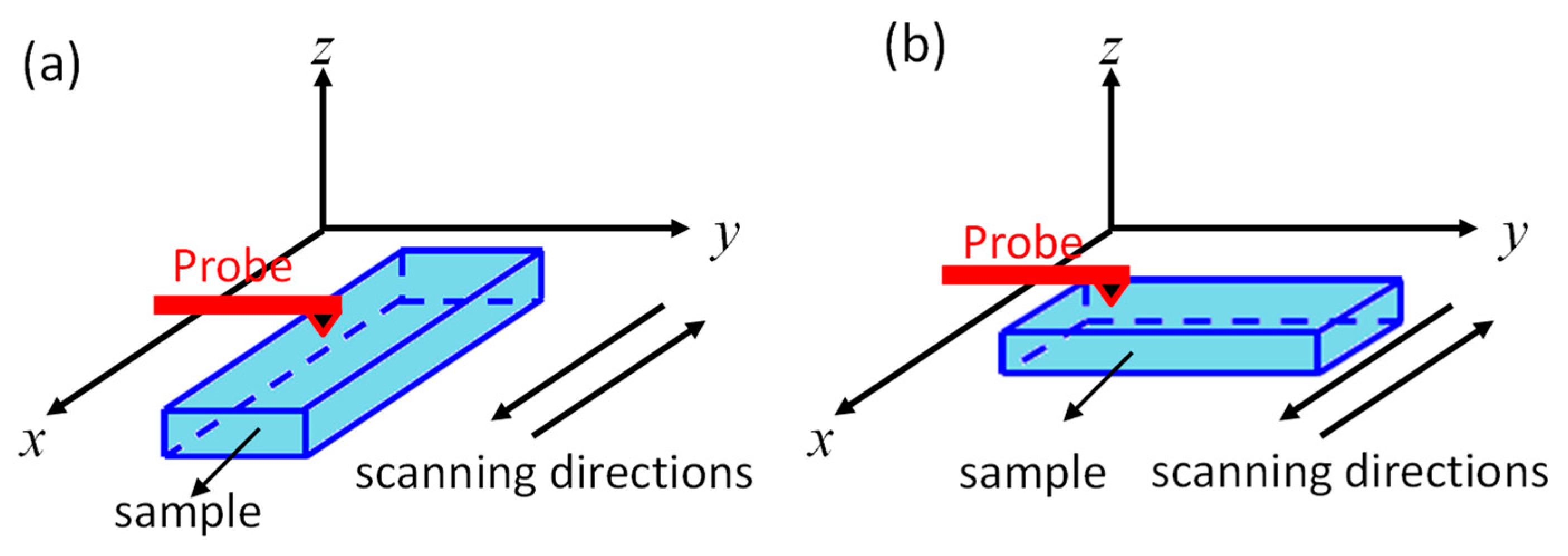
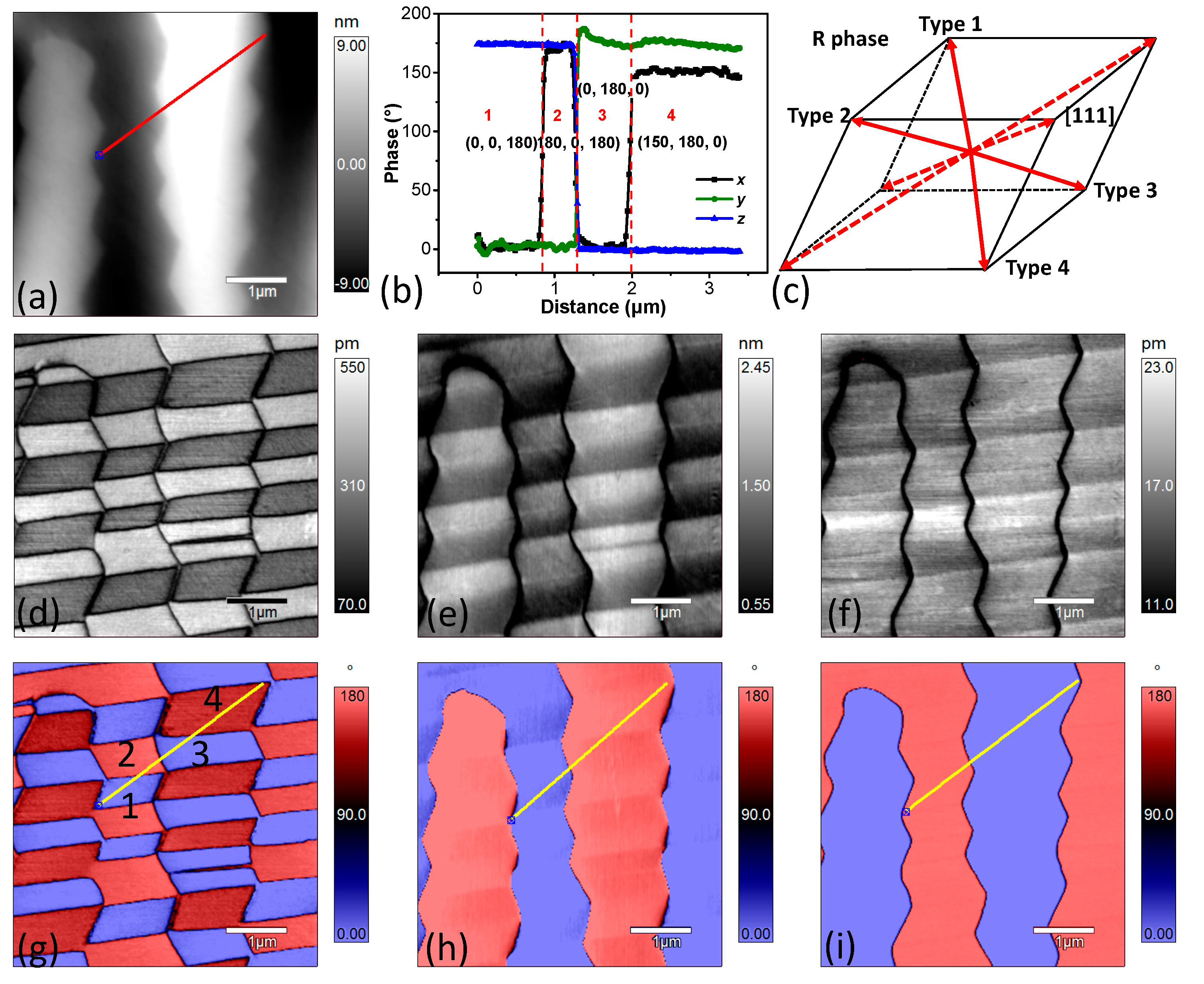

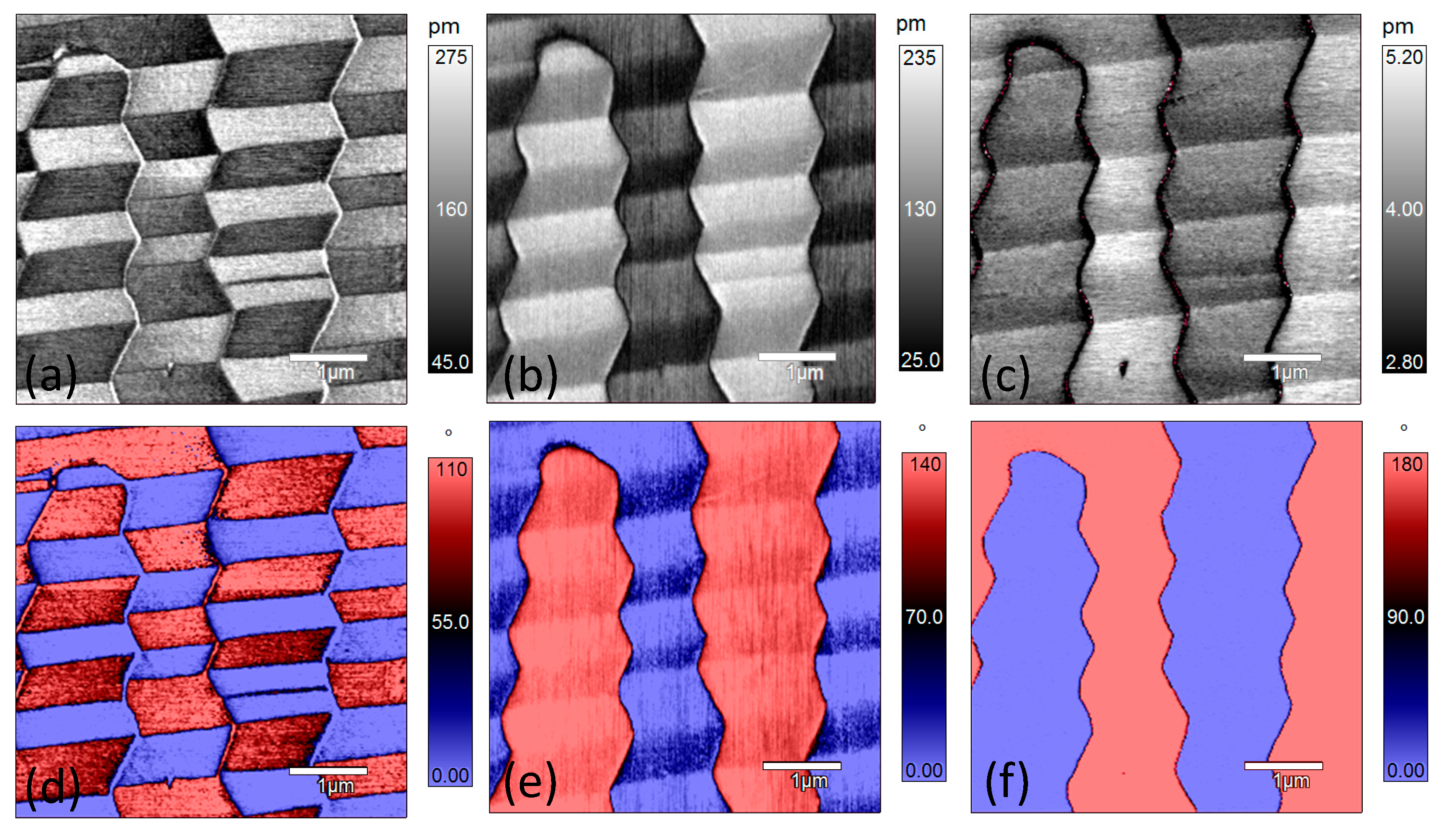

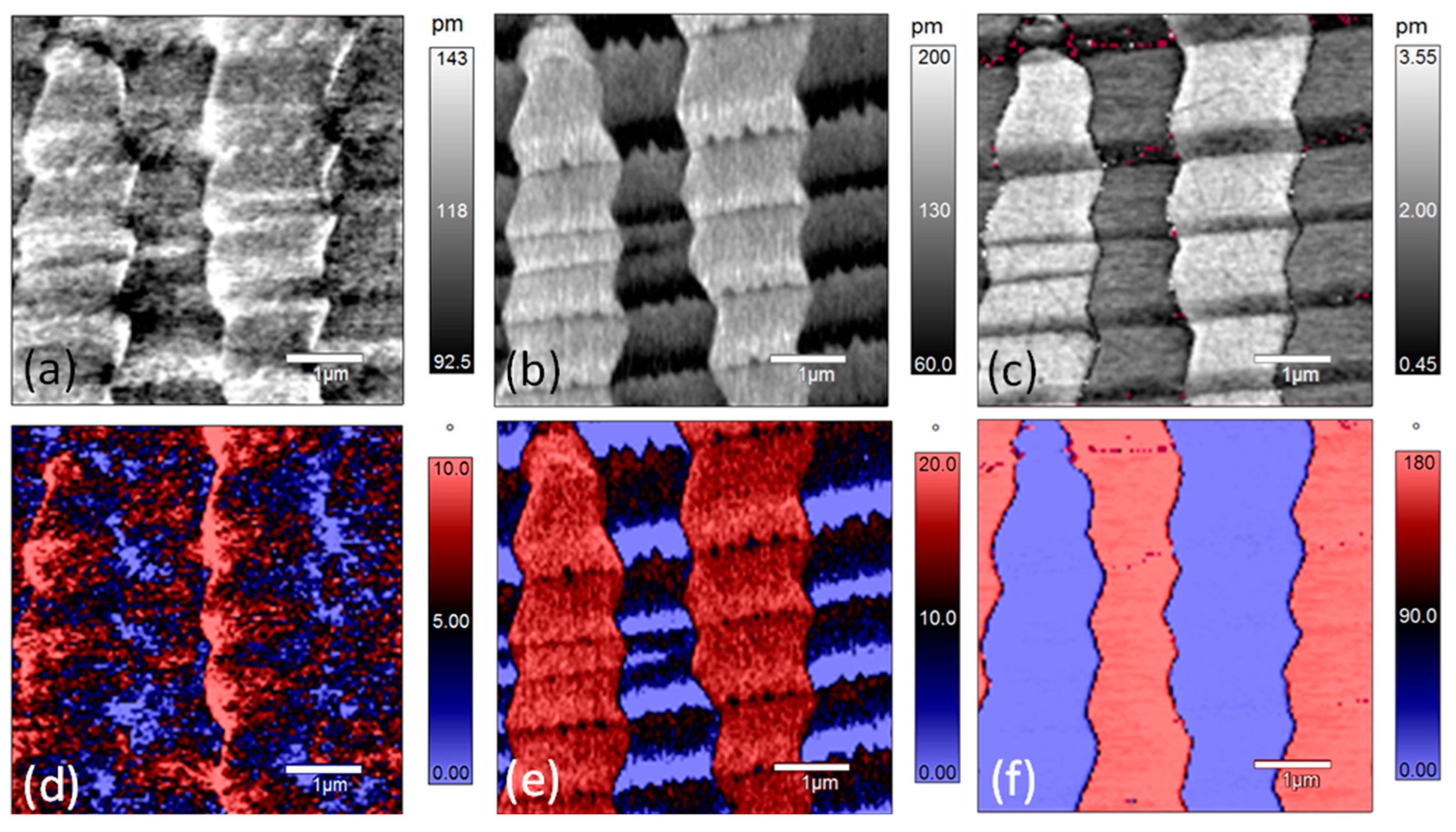

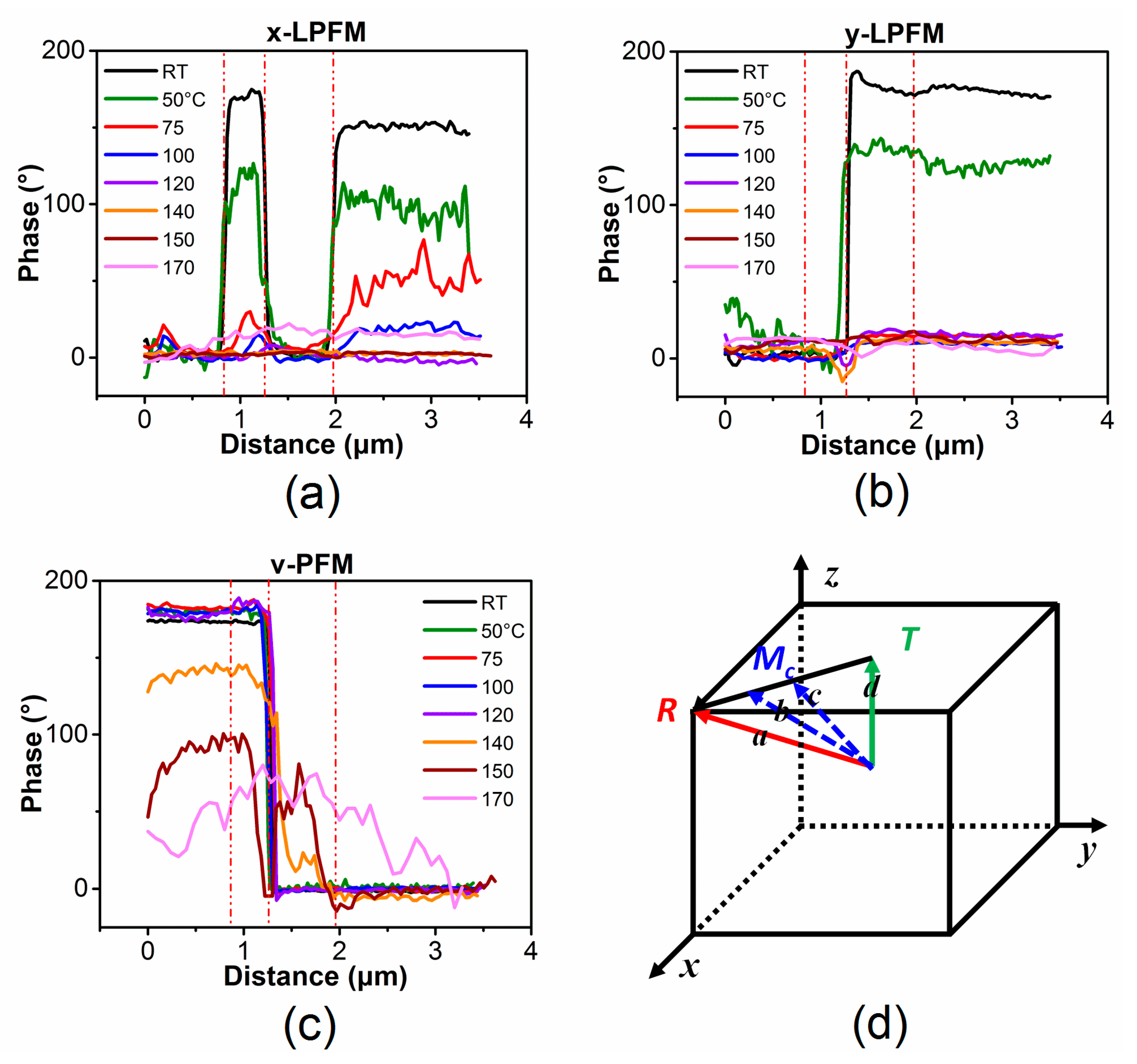
Publisher’s Note: MDPI stays neutral with regard to jurisdictional claims in published maps and institutional affiliations. |
© 2021 by the authors. Licensee MDPI, Basel, Switzerland. This article is an open access article distributed under the terms and conditions of the Creative Commons Attribution (CC BY) license (http://creativecommons.org/licenses/by/4.0/).
Share and Cite
Wang, H.; Zeng, K. Temperature-Induced Phase Transition Characteristics of [001]-Oriented 0.93Pb(Zn1/3Nb2/3)O3-0.07PbTiO3 (PZN-7%PT) Single Crystal by Using Piezoresponse Force Microscopy. Materials 2021, 14, 855. https://doi.org/10.3390/ma14040855
Wang H, Zeng K. Temperature-Induced Phase Transition Characteristics of [001]-Oriented 0.93Pb(Zn1/3Nb2/3)O3-0.07PbTiO3 (PZN-7%PT) Single Crystal by Using Piezoresponse Force Microscopy. Materials. 2021; 14(4):855. https://doi.org/10.3390/ma14040855
Chicago/Turabian StyleWang, Hongli, and Kaiyang Zeng. 2021. "Temperature-Induced Phase Transition Characteristics of [001]-Oriented 0.93Pb(Zn1/3Nb2/3)O3-0.07PbTiO3 (PZN-7%PT) Single Crystal by Using Piezoresponse Force Microscopy" Materials 14, no. 4: 855. https://doi.org/10.3390/ma14040855





